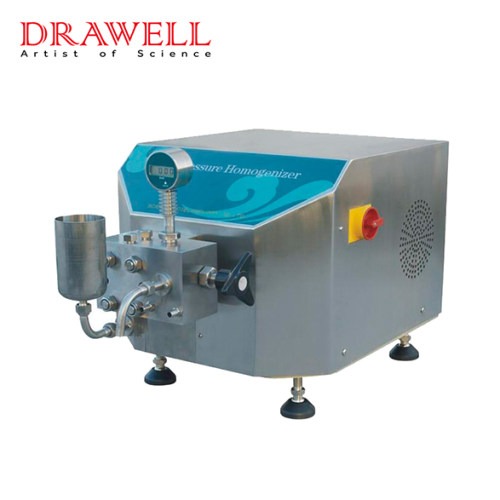High-pressure homogenizers and microfluidizers play pivotal roles in the processing of emulsions, suspensions, and dispersions, aiming to reduce particle size and ensure a uniform particle distribution. Despite their common objective, these technologies differ in their mechanisms of action and applications. This article delves into the principles behind high-pressure homogenizers and microfluidizers and provides insights into choosing the appropriate instrument based on specific considerations.
High-Pressure Homogenizer Principle:
The high-pressure homogenizer operates by pressuring a fluid mixture through a narrow orifice after being pumped into a high-pressure chamber. This pressurization, typically achieved by a reciprocating pump, propels the fluid through a small orifice, generating intense shear forces and turbulence. This process effectively breaks down particles and droplets. As the fluid exits the orifice, a sudden pressure drop induces cavitation, further reducing particle size. The homogenized fluid is then collected for subsequent processing or immediate use.

Microfluidizer Principle:
Conversely, a microfluidizer utilizes a high-pressure pumping system to propel a fluid mixture through a microfluidic chamber equipped with precisely engineered channels and chambers. As the fluid traverses these channels, it experiences significant shear and cavitation forces, leading to particle size reduction and a more uniform product. The microfluidic chamber's design involves multiple intersecting channels that create microscale eddies and turbulence, enhancing fluid mixing and homogenization. The size and geometry of these channels can be customized to achieve specific mixing and homogenization effects, making the microfluidizer a versatile tool for particle size reduction and dispersion.
Factors for Choosing Between High-Pressure Homogenizer and Microfluidizer:
To make an informed choice between high-pressure homogenizers and microfluidizers, one must consider the following factors:
Performance:
High-pressure homogenizers are well-suited for larger-scale production requiring higher throughput.
Microfluidizers excel in smaller-scale production, offering precise control over particle size and distribution.
Maintenance and Safety:
Microfluidizers generally require less maintenance due to their simpler design and fewer moving parts.
Both devices involve high pressures and necessitate adherence to proper safety protocols during operation.

Cost:
High-pressure homogenizers are typically more cost-effective for large-scale production.
Microfluidizers may offer cost savings through reduced energy consumption, a smaller footprint, and minimized material waste due to precise particle size reduction.
Conclusion:
Choosing between high-pressure homogenizers and microfluidizers hinges on the specific application and production requirement. While both technologies share the goal of achieving uniform particle distribution, their differences in performance, maintenance, safety, and cost must be carefully weighed to select the optimal instrument that aligns with the user's needs.


Comments (0)